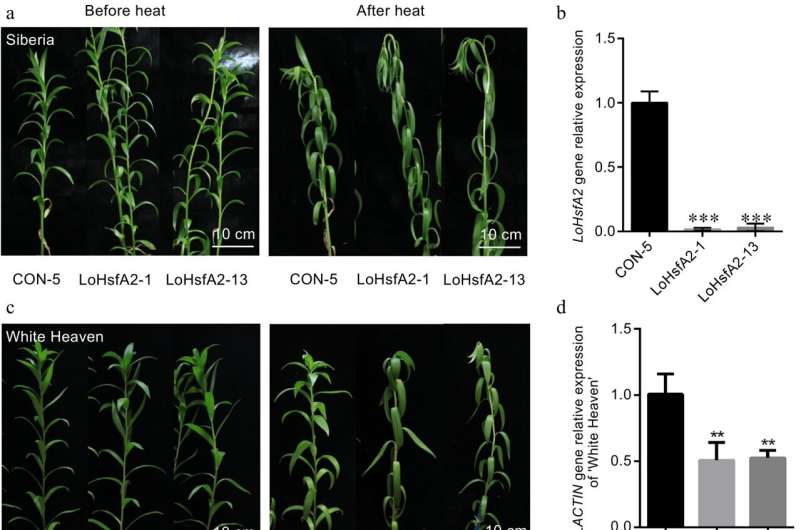This article has been reviewed according to Science X's editorial process and policies. Editors have highlighted the following attributes while ensuring the content's credibility:
fact-checked
trusted source
proofread
Heat stress survival: Unraveling the HsfA2-ACTIN dynamics in lily varieties

A research team has identified that the heat stress transcription factor HsfA2 and actin-interacting protein (AIP) LACTIN interact at the protein level in Lilium longiflorum "White Heaven," mediating gene expression and protecting cells from heat stress. This interaction does not occur in Lilium oriental "Siberia," potentially explaining the difference in heat resistance between the varieties.
These findings offer valuable insights for future studies on heat stress responses in lilies and could guide the development of heat-resistant lily cultivars.
Global warming directly alters the environmental conditions necessary for crop growth and development, affecting their maturity, extending growth cycles, and reducing yields. Plants have developed complex regulatory networks to cope with heat stress, with the heat stress transcription factor-heat shock protein (Hsf-Hsp) pathway being crucial.
Hsf transcription factors, particularly HsfA2, regulate key downstream genes under heat stress. Actin, essential for maintaining cellular stability, also plays a role in stress responses. The lilly is a globally significant cut and potted flower, occupying a pivotal position in the flower market. However, the molecular mechanisms involving actin in lily heat stress responses are not well understood.
A research article published in Ornamental Plant Research on 24 April 2024, explores the role of HsfA2 and its interaction with actin in enhancing heat resistance in lilies, providing new insights for developing heat-resistant lily varieties.
In this study, molecular cloning and protein domain analysis of HsfA2 were performed on Lilium longiflorum "White Heaven" and Lilium oriental hybrids "Siberia" to understand their heat stress responses' role.
The coding sequence of LoHsfA2 was cloned from Siberia, revealing a 1,077 bp sequence encoding a 358 amino acid protein. Amino acid sequence alignment showed high overall homology between LlHsfA2 and LoHsfA2, with conserved domains like the DNA binding domain (DBD) and nuclear localization signal (NLS). However, an AIP3 domain was present in LlHsfA2 but not in LoHsfA2.
For ACTIN gene, cloning from both varieties showed identical sequences, indicating that the ACTINs are highly conserved in different lily cultivars. Subcellular localization experiments demonstrated LACTIN's presence in the nucleus and cytoplasm. Bimolecular fluorescence complementary (BiFC) assays confirmed that LlHsfA2 interacted with LACTIN in the cell nucleus of White Heaven but not in Siberia.
Virus-induced gene silencing (VIGS) of HsfA2 and ACTIN in both varieties showed that silencing these genes decreased thermal tolerance in White Heaven but not in Siberia. Finally, qRT-PCR analysis revealed that HsfA2 and ACTIN affect each other's expression in White Heaven, forming a positive feedback loop that mediates heat tolerance.
These results provide insights into the molecular mechanisms underlying heat stress responses in lilies and suggest pathways for developing heat-resistant varieties.
According to the study's lead researcher, Junna He, "We found a new pathway by which HsfA2 regulates the plant heat stress response at the protein level and provided new theoretical support for solving the molecular mechanism of lily heat resistance."
In summary, this study identified that LlHsfA2 in White Heaven interacts with ACTIN, enhancing heat tolerance, while LoHsfA2 in Siberia lacks this interaction. Virus-induced gene silencing confirmed the crucial role of these interactions in heat stress response. These findings provide new insights into the molecular mechanisms of heat stress in lilies, suggesting pathways for developing heat-resistant varieties.
Future research will explore the specific molecular mechanisms and broader applications of these interactions in improving crop resilience.
More information: Yue Wang et al, The diversity in interaction between HsfA2 and ACTIN leads to differences in heat stress responses among different lily varieties, Ornamental Plant Research (2024). DOI: 10.48130/opr-0024-0009
Provided by Chinese Academy of Sciences


















